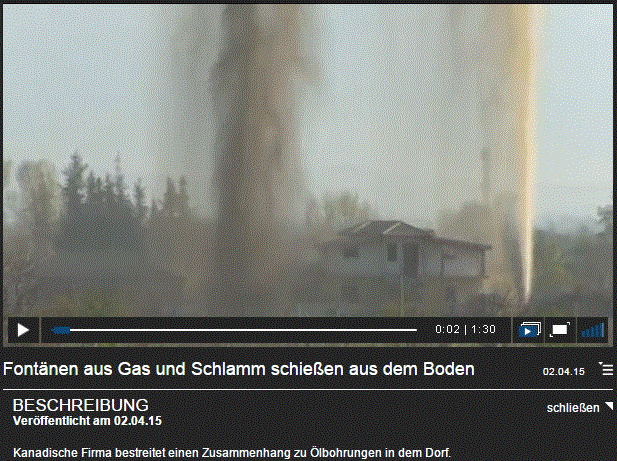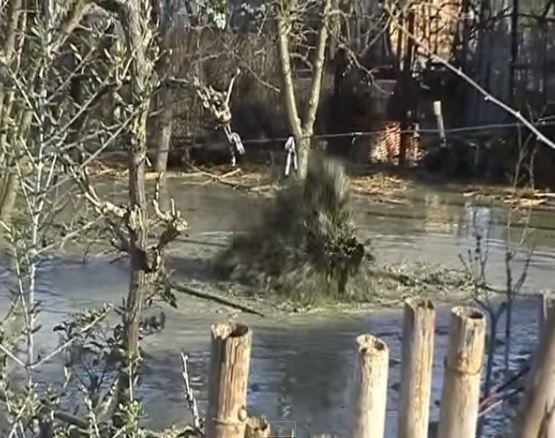California lawmakers propose ban on fracking by 2027 by Adam Beam, Feb 17, 2021, North Shore News
New legislation would ban all fracking in California by 2027, taking aim at the powerful oil and gas industry in the state already planning to ban the sale of new gas-powered cars by 2035.
Progressive California has long been a leader in combating climate change, requiring solar panels on new homes and passing a law to make the nation’s most populated state rely entirely on renewable energy by 2045.
But environmental groups say California officials — particularly governors — have long had a blind spot for the oil and gas industry, which has wielded its immense political power many times to kill or weaken legislation aimed at curtailing production.
That could be changing. Last year, Democratic Gov. Gavin Newsom announced steps to ban the sale of new gas-powered cars and called on lawmakers to go further by banning new permits for fracking, a technique to extract oil and gas embedded in rock deep beneath the surface that climate groups say harms the environment and threatens public health.
Two state senators answered that call Wednesday, announcing a measure that would halt new fracking permits or renewals by Jan. 1 and ban the practice altogether by 2027. Democratic state Sens. Scott Wiener of San Francisco and Monique Limon of Santa Barbara also say they will change the bill next month to halt new oil and gas permits within 2,500 feet (762 metres) of homes or schools by Jan. 1. ![]() AER allows companies to drill, frac and quake 330 feet (100 metres) from homes, schools, care homes, hospitals, businesses, etc, including for deadly sour gas, and covers-up when companies (eg Encana/Ovintiv) illegally frac directly into community drinking water aquifers.
AER allows companies to drill, frac and quake 330 feet (100 metres) from homes, schools, care homes, hospitals, businesses, etc, including for deadly sour gas, and covers-up when companies (eg Encana/Ovintiv) illegally frac directly into community drinking water aquifers.![]()
“This is real. It is harming so many people, and the time to deal with it in the future is over. We need to deal with it now,” Wiener said.
The oil and gas industry quickly pushed back. Catherine Reheis-Boyd, president and CEO of the Western States Petroleum Association, said the legislation was “so broad and ambiguous” it would “lead to a total (oil) production ban in California.”
Rock Zierman, CEO of the California Independent Petroleum Association, called the measure “legally questionable.” ![]() Companies will threaten to sue, or will sue to try to block the attempts by elected officials to protect the citizenry, environment, food lands and drinking water.
Companies will threaten to sue, or will sue to try to block the attempts by elected officials to protect the citizenry, environment, food lands and drinking water.![]()
“Shutting down energy production under the toughest regulations on the planet will devastate the economies of oil-producing regions,” Zierman said.
Newsom, speaking at an unrelated news conference in the Coachella Valley, said he had not read the proposal yet and was “unable to comment on it.”
California was among the top oil-producing states in the country, reaching a peak of 394 million barrels in 1985. But by 2017, production had dropped significantly, and it now ranks behind Texas, North Dakota, New Mexico, Oklahoma, Colorado and Alaska, according to the U.S. Energy Information Administration.
Part of the reason is the industry has exhausted much of California’s easily extractable oil reserves. ![]() Same in Canada.
Same in Canada.![]() What’s left is embedded deep in rock underground that requires immense energy to extract. That includes using processes like fracking, cyclic steaming, acid well stimulation and water and steam flooding to separate the oil from the rock — all processes that would be banned by 2027 under the new legislation.
What’s left is embedded deep in rock underground that requires immense energy to extract. That includes using processes like fracking, cyclic steaming, acid well stimulation and water and steam flooding to separate the oil from the rock — all processes that would be banned by 2027 under the new legislation.
“It’s some of the dirtiest oil in the world,” said Hollin Kretzmann, an attorney at the Center for Biological Diversity’s Climate Law Institute. ![]() Alberta’s is dirtier.
Alberta’s is dirtier.![]()
Environmental groups say those methods can cause significant harm to air quality and water supplies. Research published this month by a team at Harvard University estimated that 8.7 million people worldwide died prematurely from fossil fuel pollution in 2018, including 34,000 people in California, the Desert Sun in Palm Springs reported.
“We must stop doing what we know causes death and disease,” said Dr. Karina Maher, a pediatrician in Los Angeles who works with the advocacy group Climate Health Now.
But critics say halting the state’s oil production won’t stop the state’s reliance on oil because millions of people still drive gas-powered cars. State Sen. Shannon Grove, a Republican whose district includes parts of Kern County, said that if the bill becomes law, it would force the state to “rely on foreign countries with dismal human rights records that barely let women drive and have little to no regard for the environment.” ![]() That silly Rebel/Steve Harper gov’t story is stale and lame. Abuse of the environment and women and children is horrific right here in North America, including by Canadian courts! No need to peer down ego over-blown noses at others.
That silly Rebel/Steve Harper gov’t story is stale and lame. Abuse of the environment and women and children is horrific right here in North America, including by Canadian courts! No need to peer down ego over-blown noses at others.![]()
Republican Assemblyman Vince Fong, who also represents Kern County, said California produces oil “in the most environmentally responsible way.”
“At a time like now, when we need to be revitalizing our economy, I don’t quite understand why we would be pushing legislation that eliminates jobs in our state,” he said.
California has more than 5,500 oil wells that have likely been abandoned and could cost more than half a billion dollars to clean up, according to an assessment by the California Council on Science and Technology. For companies that eventually do that work, the legislation would require the state to offer them undefined “incentives” to hire laid-off oil and gas workers.
Wiener says it makes sense to start preparing for the eventual decline of the oil and gas industry and try to avoid the fate of the coal industry, whose decline has devastated communities in the Appalachian region.
“It’s a declining industry. And instead of waiting for it to eventually decline and fall apart, let’s get ahead of it, facilitate the phasing out and help the workers,” Wiener said.
Bill would ban fracking, other risky California oil production techniques by 2027 by Janet Wilson, Feb 17, 2021, EPalm Springs Desert Sun
Two California state senators on Tuesday introduced legislation that would halt all new fracking, steaming and other risky oil and gas production techniques next year, and end them completely by 2027.
The bill, SB 467, “End Fracking & Harmful Drilling Act” will also include a renewed bid to require a 2,500-foot setback between oil operations and neighborhoods and prisons, going beyond buffers already in place in Texas, Colorado and elsewhere mandating separation between hazardous facilities and schools or residences.
The legislation, authored by Sen. Scott Wiener (D-San Francisco) and Sen. Monique Limon (D-Santa Barbara), is certain to face stiff headwinds from oil industry lobbyists and building and trade unions.
In a bid to ease economic disruption and win support, Wiener and Limon have included a provision that would require the state’s main oil regulator, the California Geologic Energy Management division, to identify oil workers have lost their jobs, and via companion legislation, fund incentives for contractors cleaning up old wells to hire them.
The bill was crafted in response to Gov. Gavin Newsom’s request to the Legislature in September to ban new fracking in five years. But it goes much faster and further.
Approximately 2.1 million Californians — many of them low-income and nonwhite — live near active oil fields. Given the health threats to these communities, and rising climate change impacts, Weiner said it is time to act.
“It’s a hard, hard bill, but it’s a righteous bill, and we’re going to do everything we can to get as much of it passed as we possibly can,” said Wiener. He said strong action is needed to slash greenhouse gases like methane emitted from oil sites, and to thwart threats to public health, water supplies and wildlife from oil and gas production.
“We have no time to waste,” added Wiener. “Extracting massive amounts of oil — particularly with destructive techniques — is totally inconsistent with California’s commitment to a sustainable climate future. It’s time to transition.”
Rock Zierman, chief executive officer of the California Independent Petroleum Association, wasted no time responding. In a statement, he said the legislation would “virtually ban all oil production in California, killing thousands of quality highly-skilled, union careers that cannot be replaced by low-skilled and temporary jobs in the renewable industry” and would “make the Saudi royal family even richer all while eliminating the industry that is investing in the innovation needed to significantly reduce the state’s carbon footprint.”
At a press conference in Coachella where he watched farmworkers receive COVID-19 vaccines, Gov. Newsom had no immediate comment, saying, “Humbly I submit I have not read what was introduced, apparently a few hours ago, so I am unable to comment on it until I have that privilege.”
Limon said her top concerns were the health effects of oil extraction and the costs to taxpayers of cleaning up abandoned wells; she said she wanted to and take action at the state level that mirrors President Joe Biden’s efforts to pause new oil and gas leases on public lands and in ocean waters.
“Oil production in and near our communities has had long-lasting health impacts. This bill continues robust policy conversations on fossil fuels and alternative energy production,” she said. “Even more important is that we have these conversations simultaneously as President Biden takes action on pausing new oil and natural gas leases on public lands or offshore waters.”
Oil production in California has been dropping
Oil production has been declining in the Golden State since the mid-1980s, as supplies of light, easily harvested crude run out in some of the largest, oldest oil fields in Southern California and the San Joaquin Valley, and as natural gas is increasingly used instead because it is less polluting. But the state is still the seventh-largest oil and gas producer in the U.S.
To get at the remaining, far heavier crude that is tough to extract, operators now rely on “unconventional” techniques like blasting open formations with cycles of scalding steam, injecting acid chemical cocktails or flooding underground reserves with copious amounts of water. The aim is to force gooey, tarry crude to the surface for refining and selling. While hydraulic fracking is better known because of national battles over its risks, Golden State producers rely much more on steaming and waterflooding.
All the techniques carry risks — and rewards. Over the past two decades, Chevron and other oil companies in California have earned millions harvesting oil from destructive, sometimes deadly spills linked to high-pressure cyclic steaming, according to an investigation by The Desert Sun and ProPublica.
Wiener said he was “horrified” to read about cyclic steaming and its effects on workers, wildlife and the environment. “It’s very harmful. It just shouldn’t be happening,” he said.
UC Berkeley estimated last year that as much as 40% of California’s crude now comes from steaming. CalGEM told The Desert Sun and ProPublica in October that 18,600 wells are used for steam injection and flooding, with about 4,500 used for high-pressure cyclic steaming. There were 84,000 active wells overall in the state in 2015, though the numbers have been dropping.
The logistics of safely shutting down tens of thousands of wells are daunting. Subsidence is a major concern, said Tom Williams, a retired energy and infrastructure planning engineer who now helps community environmental groups. Portions of Wilmington and Long Beach in particular could see major cracks, drops and uplifts if wells are not properly balanced with water and plugged long-term.
Another bill to address oil well clean-up
Limon last week introduced Senate Bill 47, which would extend and more than triple the fees that the California Geologic Energy Management division (CalGEM) is entitled to collect from oil producers for an idle and hazardous oil well clean-up fund. The bill raises the amount from $3 million to $10 million total annually from all producers. ![]() No where near enough.
No where near enough.![]()
According to a report last year by the California Council on Science and Technology, it could ultimately cost between $500 million and $6 billion to properly plug all the state’s idle wells and restore sites around them.
“Deserted wells can pose a range of hazards to the public and the environment, including contaminating aquifers, creating oil seeps, endangering local wildlife, degrading air quality, increasing greenhouse gas emission, and threatening public health and safety,” Limon said in a statement. “SB 47 is a significant step to ensure that the oil and gas industry pays for the remediation of hazards that the industry has historically left behind.”
The funds could also help oil workers whose jobs would be lost. Wiener said he has spoken with Robbie Hunter, the head of the Building Trades Council, and other labor leaders, who are opposed so far to SB 467.
“I understand that they have skepticism that the jobs will materialize,’ he said. “They’ve been burned before … In general economic transitions sometimes work out well for workers and sometimes they don’t.”
There are other concerns.
Catherine Reheis-Boyd, president of the Western State Petroleum Association, said the bill, if passed and signed, is “so broad and ambiguous” that it could lead to state taxpayers shouldering “potentially billions in takings claims” by oil companies whose property was impacted by setbacks.
“When we look past political rhetoric and to the facts, it is clear the last thing we can afford to do is shut down oil and gas production,” she said.
Several Kern County Republican legislators and one Orange County Democrat, Sharon Quirk (D-Fullerton) spoke out against banning fracking or other extraction techniques that boosts the state’s sagging output at a virtual press conference hosted by CIPA last month. They urged Newsom to block any such legislation and abandon his own, slower approach to transition the state away from fossil fuels.
But Wiener is relying on backing from scores of environmental groups, shepherded by the Kern County-based Center on Race, Poverty and the Environment.
“We are very supportive of the legislation, because it really looks at those drilling practices that are most harmful to people. By addressing those dangerous practices, we can really protect those residents in California that are the most impacted,” said CRPE assistant director Ingrid Brostrom.
Kern County is home to more than two-thirds of the state’s oil drilling. Brostrom said communities large and small, from Bakersfield to Lost Hills, Arvin and Oildale, are affected by fumes that studies have shown can exacerbate issues from headaches to asthma to miscarriages, and which can contaminate drinking and irrigation water.
Brostrom also said claims about numbers of jobs that might be lost were in some cases inflated. Out of 16.2 million jobs statewide, 7,700 are directly connected to the oil and gas sector, with 3,400 of those jobs in Kern County, according to an October 2020 analysis by UC Berkeley economists and the U.S. Bureau of Labor Statistics. The average blue-collar wage is $55,600, the study found.
Most are non-union jobs, Brostrom said. But some oil companies have instituted contracts with some unions in Kern County. Several other legislators have agreed to be co-authors. In prepared statements, other environmental groups also expressed support.
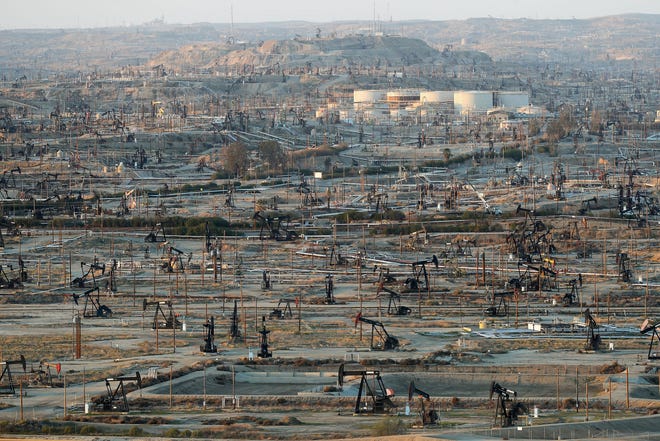
Feb 20, 2020: Kern County Oilfield, Bakersfield, California. Jay Calderon, Desert Sun
“This bill boldly tackles head-on the need to prioritize the phasing out of the types of drilling that are directly harming California communities,” said Ann Alexander, a senior attorney for the Natural Resources Defense Council. “It is time that California’s leaders take on the state’s behemoth oil industry.”
“Extreme oil extraction measures are just that: extreme,” said Lauren Cullum, policy advocate at Sierra Club California. “This bill will save lives, protect water sources, and cut air pollution without risk to the economy.”
“What this bill aims to do is simple: protect people’s drinking water and air from risky oil extraction while providing a piece of the just transition puzzle for affected workers,” said Tara Messing, staff attorney for the Environmental Defense Center representing Satna Barbara, where dozens of spills linked to cyclic steam have occurred. “Last year, the governor signaled it was time to stop this type of oil development and the legislature has now come up with a solution.”

A few frac harms by one company:
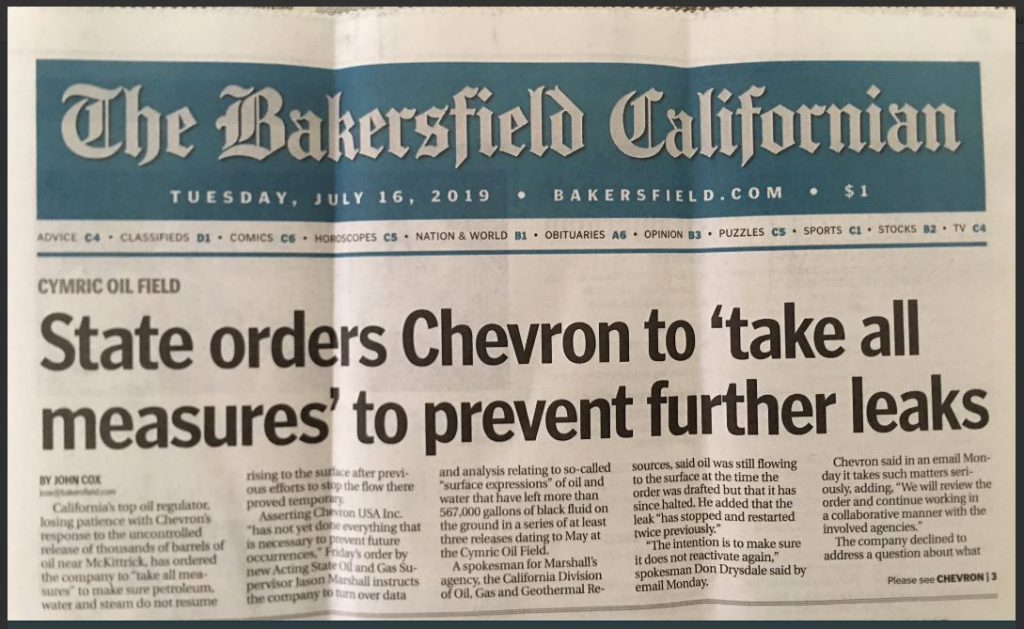
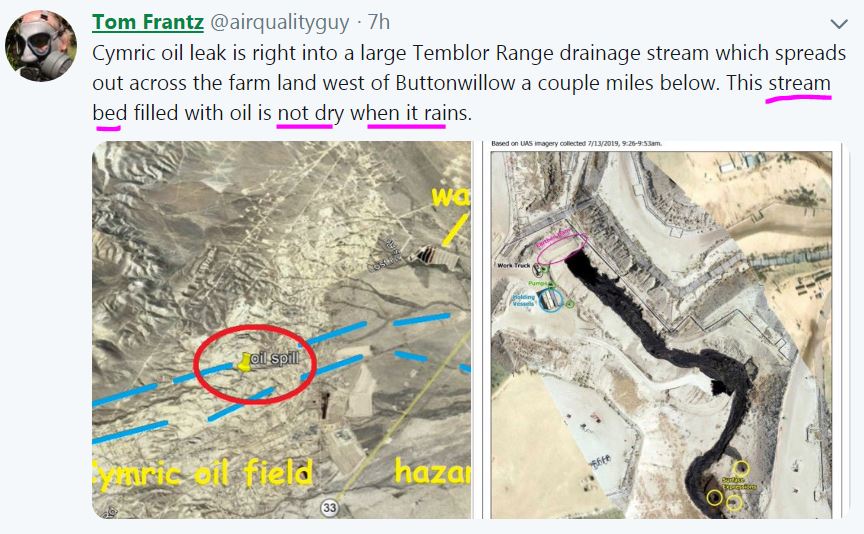
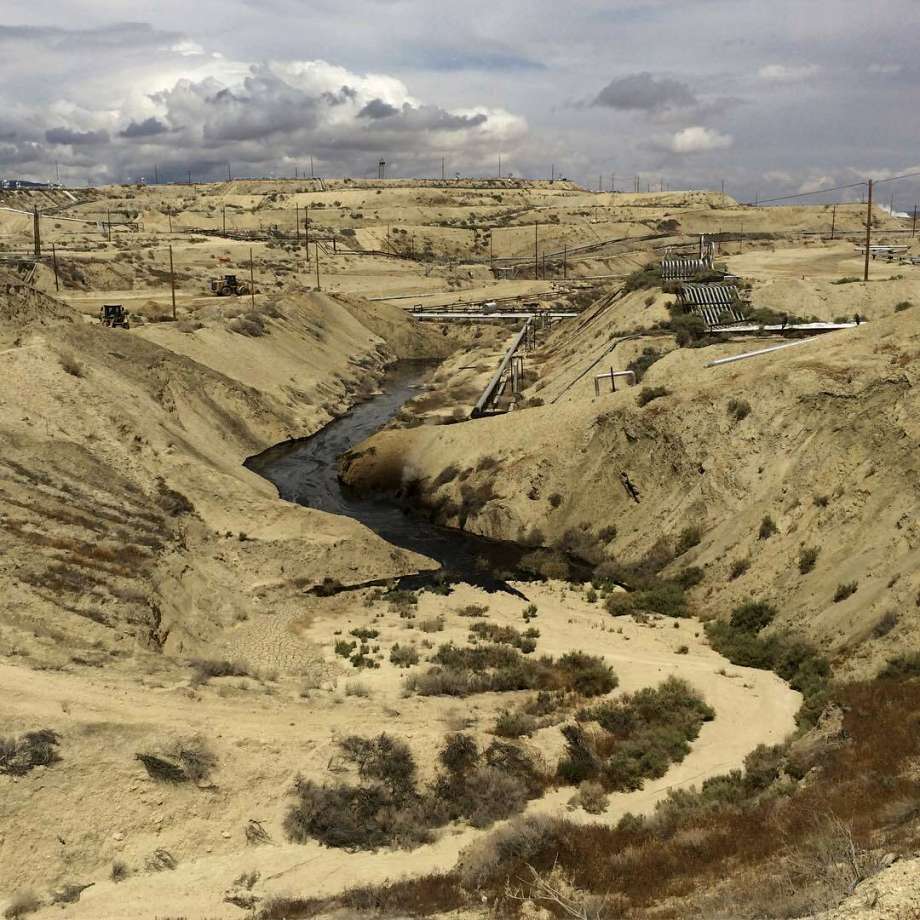
Chevron steam injection in California
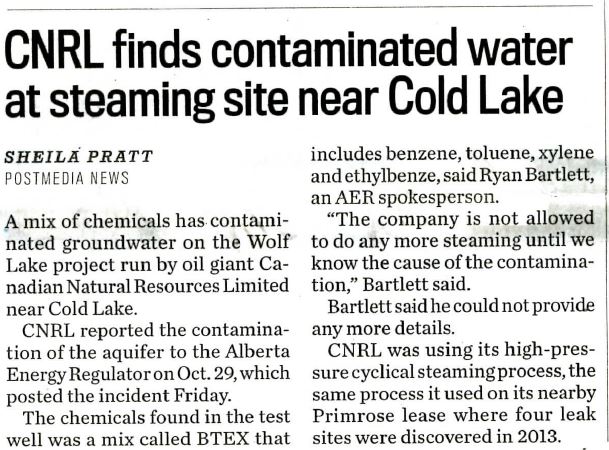
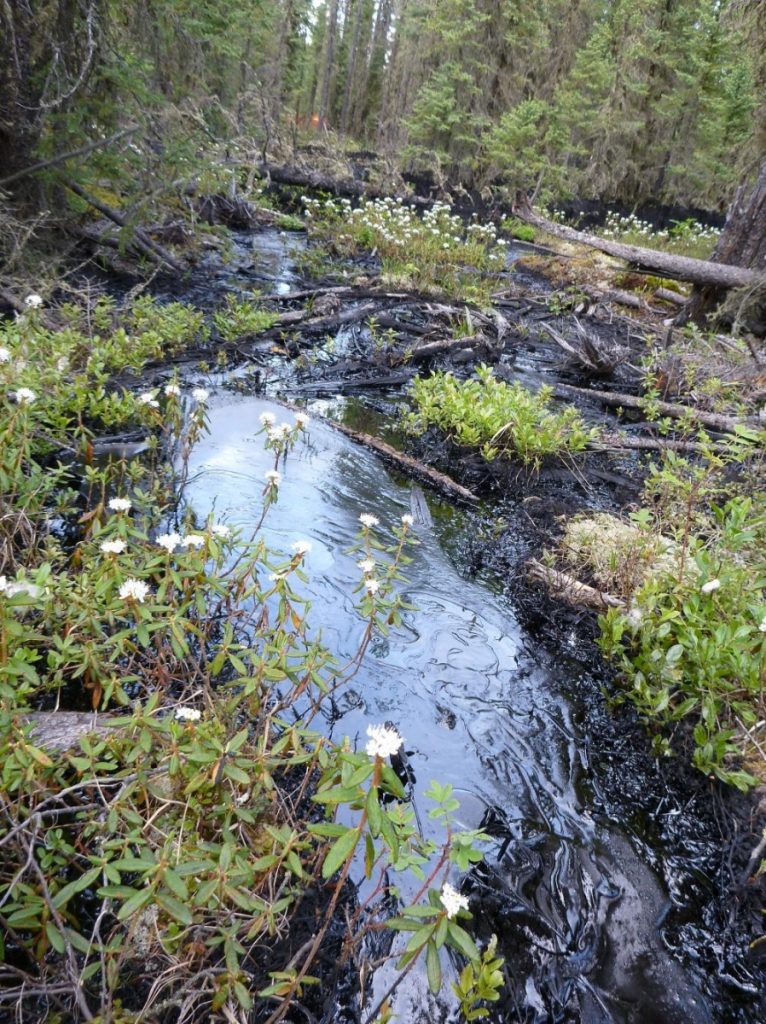
CNRL steam injection in Alberta
“Abnormally dangerous and ultra hazardous activity.” Did TRC or Chevron’s fracing kill Robert David Taylor? What happened to California regulators’ vows to make steam injections safer? “Safer?” Why not make it “safe?”

As the crew walked the site, surrounded by a landscape dense with new and old wells and miles of pipes and casings, the ground gave way beneath Taylor. He fell feet first into a cavity burbling with 190-degree water and hydrogen sulfide.
Co-workers rushed to the brink but could not reach him. As they extended a length of pipe for him to grasp, Taylor slid further into the 10-foot diameter crater.
His wife stood vigil beside the sinkhole until rescuers could retrieve his body 17 hours later. … The California Division of Occupational Safety and Health closed the case after a two-month investigation, finding no violations. “They kind of concluded that it was like an act of God,” said Peter Melton, a spokesman for the agency.
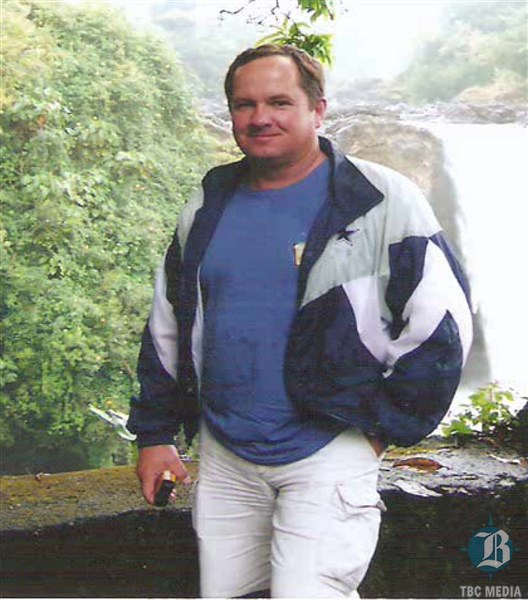
Robert David Taylor
Romanian peasants’ revolt against hydraulic fracturing, Chevron tries to bribe with yoghurt
The Chevron Frac Guarantee: Our well won’t explode…or your pizza is free!
BP, Chevron Accused Of Illegally Dumping Toxic Radioactive Drilling Waste Into Louisiana Water
Constitutional protection, Judge gives way to request on Chevron frac deal in Argentina
Criminal investigation at Chevron refinery, Pollutants allegedly routed around monitoring devices
Chevron and Exxon Shareholders Send Strong Message Today About Need to Disclose Environmental and Financial Risks of ‘Fracking’ but of course, refuse to do the deed.
And this steam injection horror show:
